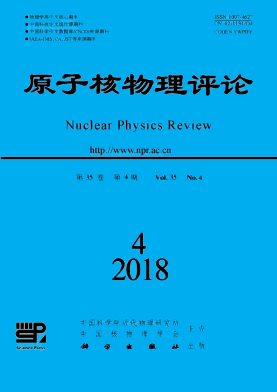|
[1]
|
BUCURESCU D, ZAMFIR N V. Phys Rev C, 2018, 98:024301. |
|
[2]
|
PAN F, LI D, CHENG G, et al. Phys Rev C, 2018, 97:034316. |
|
[3]
|
PAN F, YUAN S, QIAO Z, et al. Phys Rev C, 2018, 97:034326. |
|
[4]
|
ZHANG Y, PAN F, LIU Y X, et al. Phys Rev C, 2017, 96:034323. |
|
[5]
|
PAVEL C, PAVEL S. Phys Scr, 2016, 91:083006. |
|
[6]
|
MARJARSHIN A J, JAFARIZADEH M A, SABRI H. et al. Eur Phys J Plus, 2017, 132:418. |
|
[7]
|
GREINER W, MARUHN J A. Nuclear Models[M]. Berlin:Springer, 1996. |
|
[8]
|
IACHELLO F AND ARIMA A. The Interacting Boson Model[M].Cambridge:Cambridge University Press, 1987. |
|
[9]
|
HEYDE K. in Algebraic Approaches to Nuclear Structure[M]. Swizerland:Hardwood Academic Publishers, 1993. |
|
[10]
|
CAPRIO M, SKRABACZ J, IACHELLO F. J Phys A:Math Theor, 2011, 44:075303. |
|
[11]
|
CEJNAR P, STRANSKY P, KLOC M. Phys Scr, 2015, 90:114015. |
|
[12]
|
JAFARIZADEH M A, MARJARSHIN A J, FOULADI N. Int J Mod Phys E, 2016, 25:1650089. |
|
[13]
|
VON BRENTANO P, ZAMFIR N, ZILGES A. Phys Lett B, 1992, 278:221. |
|
[14]
|
JUNGCLAUS A, BORNER H G, JOLIE J, et al. Phys Rev C, 1983, 47:1020. |
|
[15]
|
S. LERMA H., ERREA B, DUKELSKY J, et al. Phys Rev C, 2006, 74:024314. |
|
[16]
|
SPIEKER M, BUCURESCU D, ENDRES J, et al. Phys Rev C, 2013, 88:041303. |
|
[17]
|
MARJARSHIN A J, JAFARIZADEH M A. Nucl Phys A, 2017, 968:287. |
|
[18]
|
ZAMFIR N V, KUSNEZOV D. Phys Rev C, 2001, 63:054306. |
|
[19]
|
KUYUCAK S, HONMA M. Phys Rev C, 2002, 65:064323. |
|
[20]
|
LONG G L, SHEN T Y, JI H Y, et al. Phys Rev C, 1998, 57:2301. |
|
[21]
|
JAFARIZADEH M A, MARJARSHIN A J, FOULADI N, et al. J Phys G:Nucl Part Phys, 2016, 43:095108. |
|
[22]
|
SPIEKER M, PASCU S, ZILGES A, et al. Phys Rev Lett, 2015, 114:192504. |
|
[23]
|
GARRETT P, LEHMANN H, JOLIE J, et al. Phys Rev C, 1999, 59:2455. |
|
[24]
|
PASCU S, ENDRES J, ZAMFIR N V, et al. Phys Rev C, 2012, 85:064315. |
|
[25]
|
PAN F, DRAAYER J P. Nucl Phys A, 1998, 636:156. |
|
[26]
|
PAN F, ZHANG X, DRAAYER J P. J Phys A:Math Gen, 2002, 35:7173. |
|
[27]
|
KUSNEZOV D. J Phys A:Math Gen, 1990, 23:5673. |
|
[28]
|
UI H. Ann Phys, 1968, 49:69. |
|
[29]
|
DAI L, PAN F, DRAAYER J P. Nucl Phys A, 2017, 957:51. |
|
[30]
|
PAN F, ZHOU D, DAI L R, et al. Phys Rev C, 2017, 95:034308. |
|
[31]
|
MARJARSHIN A J, SABRI H. Nucl Phys A, 2017, 964:69. |
|
[32]
|
MARJARSHIN A J. Eur Phys J A, 2018, 54:11. |
|
[33]
|
RACAH G. Phys Rev, 1942, 62:438. |
|
[34]
|
TROLTENIER D, MARUHNW J A, GREINER W, et al. Z Phys A, 1991, 338:261. |
|
[35]
|
BHARTI A, DEVI R, KHOSA S K. J Phys G:Nucl Part Phys, 1994, 20:1231. |
|
[36]
|
SINGH A J, RAINA E K. Phys Rev C, 1995, 53:1258. |
|
[37]
|
BHARTI A, KHOSA S K. Phys Rev C, 1996, 53:2528. |
|
[38]
|
GIANNATIEMPO A, NANNINI A, SONA P, et al. Phys Rev C, 1995, 52:2969. |
|
[39]
|
DE FRENNE D, NEGRET A. Nucl Data Sheets, 2008, 109:943. |
|
[40]
|
BLACHOT J. Nucl Data Sheets, 2000, 91:135. |
|
[41]
|
DE FRENNE D, JACOBS E. Nucl Data Sheets, 2000, 89:481. |
|
[42]
|
DE FRENNE D, JACOBS E. Nucl Data Sheets, 1996, 79:639. |
|
[43]
|
BLACHOT J. Nucl Data Sheets, 2012, 113:515. |
|
[44]
|
BLACHOT J. Nucl Data Sheets, 2010, 111:717. |
|
[45]
|
MCCUCHAN E, BONATSOS D, ZAMFIR N V, et al. Phys Rev C, 2007, 76:024306. |
|
[46]
|
CHABAB M, LAHBAS A, OULNE M. Eur Phys J A, 2015, 51:1. |






 甘公网安备 62010202000723号
甘公网安备 62010202000723号 DownLoad:
DownLoad: